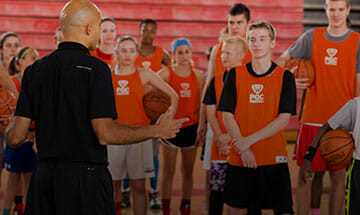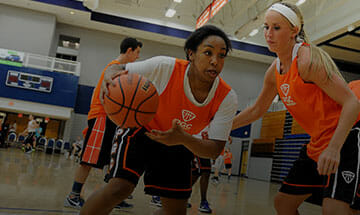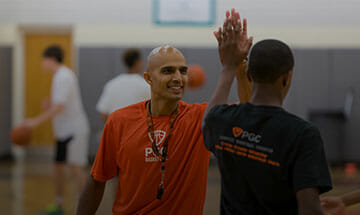How to Achieve Peak Performance
How to achieve Peak Performance
There is a basic human instinct that is as old as ‘fight or flight’. When a person feels threatened or under pressure, our body automatically reacts with basic physiological responses. These automatic reactions can hinder athletic performance, if we let them. It is vital to understand how our body and our mind responds to playing under pressure so we can control those automatic responses and keep them from hindering performance. Most young basketball players don’t know how to control their body’s reaction, so most remain a victim of these automatic responses.
Every competitive basketball player knows the feeling right before a big game. The crowd has the buzz of excitement, the band is playing, the basketball coach is giving last minute reminders, and there is a ball of excitement building inside your chest. Whether you call this nerves, adrenaline, or tightness, it invokes the same physical reaction.
- First, the sphincter muscle tightens. This muscle surrounds the stomach and the intestines and so we feel the tightening of the sphincter muscle in the pit of our stomach; this is also called “butterflies”.
- The second thing that happens is the solar plexus or the chest plate, becomes rigid and begins to constrict. This is what creates the ‘tightness’ we feel at the beginning of games, and in the moment of truth towards the end.
These natural, automatic reactions to performing under pressure impact a very important aspect of athletic performance, breathing. When we feel the tightness, we forget to breathe and we don’t get as much oxygen into the lungs. The tightness builds to a point where we can’t perform reflexive athletic movements and find it difficult to get our breath.
NBA legend, Larry Bird, was in many pressure situations throughout his basketball career. He is one of the best clutch basketball players the basketball world has ever seen. Larry Birds’s teammates, coaches, or anyone who sat court side have said that when they saw and heard Larry play, they were shocked by the volume of his breathing. He was a lanky 6’9″ man, sprinting up and down the basketball floor and all one would hear was the sound of his breathing – deep, in through the nose and exhale through the mouth.
The best way to counteract tightness, to loosen the chest plate, solar plexus and sphincter, is to practice deep breathing. This will counteract, the tightness, lack of breath, and nerves in pressure situations. Make it a habit to breathe intentionally.
READ MORE: How to Play in a National Championship
PRESSURE ALSO IMPACTS OUR MIND.
Don’t think of a White Horse!
I bet you did. I guarantee you saw a white horse in your mind.
There are two worlds we can choose to live in. As an athlete we can choose to be a part of the world of ‘do’ or ‘do not’.
When most basketball players make a mistake, miss a shot, or are under pressure, they focus on what not to do:
- Don’t miss long
- Don’t throw the basketball away
- Don’t get beat on defense
Words have power, and negative words carry negative power. When your thoughts before you shoot is “Do not miss. Do not miss,” you will likely miss. When your mind is constantly telling you “Do not turnover the basketball”, you likely will.
Instead live in the world of do.
- Do get wide and run the lane hard in transition.
- Do box out your man on defense.
- Do get your legs loaded and ready to shoot the basketball.
These are all positive focus points, which help you play a game and live in a world of action, not reaction. When you feel pressure, focus on one thing to do – breathe. Then do it again and again. It is amazing how this will impact your performance.
Coaches, we challenge you to live in the world of do as well. Instead of coaching your basketball players on what not to do, give them the positive alternative. Many times in a game, when a mistake is made, our first reaction is to coach the mistake.
- Don’t throw the basketball away.
- Don’t run at the ball.
- Don’t foul.
- Don’t take that bad shot.
These statements are a sure-fire way to reinforce negatives and invite reactive excuses from your players. Instead, coach in the positive.
- Do show your hands to the referee.
- Do move off of penetration.
- Do be ready to shoot.
- Do help earlier.
Give your players an action for them to focus on. It’s a far more powerful method of coaching and it will increase the energy of your players.
Remember, when a person feels threatened or under pressure, our body automatically reacts with basic physiological responses. Instead of allowing these reactions to dictate your performance: Breathe and Do.
Related Articles
5 Ways to Practice Mental Toughness
Here are five ways to practice your mental toughness off the court. If you practice these five things, every day, you’ll develop greater self-discipline. You’ll become unstoppable in anything you do. It is five things you will have to rise above your feelings every day. That is how you build mental toughness. You develop, as a habit, a muscle of rising above your feelings to level of your aspirations and commitments.
Why Is My Performance Inconsistent?
Do you ever feel like your performance in games is consistently inconsistent? That you’re putting in the same hard work at practice every day, yet some days you play really well and others you don’t play well at all? If that’s you, you’re not alone. If that’s not you, don’t worry—the frustration is coming soon!
Quit Being So Hard to Coach
COACHES HAVE FAVORITES!! Of course, they have favorites—their favorites are the players they can trust, on and off the court.
Here are four reasons you may not be getting the playing time you think you deserve.
About PGC
PGC Basketball provides intense, no-nonsense basketball training for players and coaches. Our basketball camps are designed to teach players of all positions to play smart basketball, be coaches on the court, and be leaders in practices, games and in everyday life.
We combine our unique PGC culture with a variety of teaching methods and learning environments to maximize the learning potential of those that attend our sessions. In addition to spending 6-7 hours on the court each day, lessons will be reinforced through classroom sessions and video analysis.
Our goal at PGC is to empower you with the tools to fulfill your basketball dreams, while also assisting you in experiencing the joy of the journey.
To learn more about PGC Basketball, including additional basketball training tips and videos, visit our YouTube Channel or find us on Facebook, Instagram, and Twitter.













Share This Post